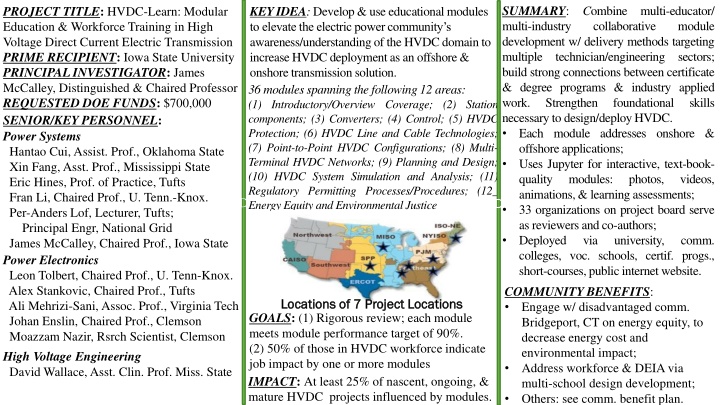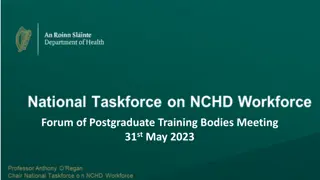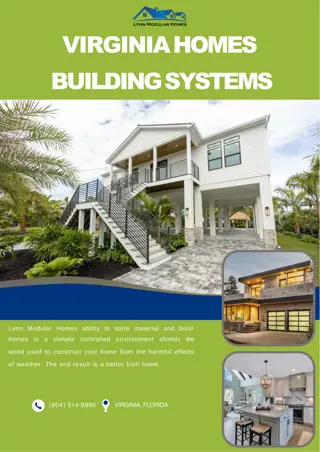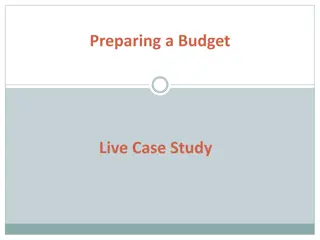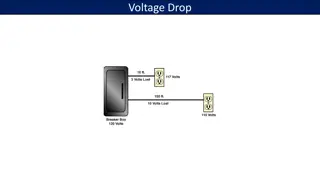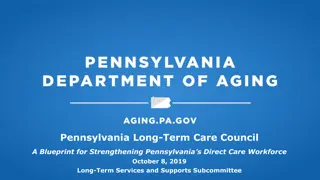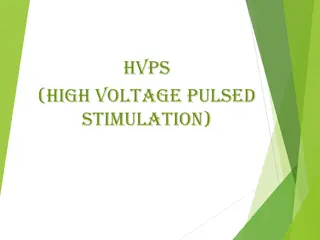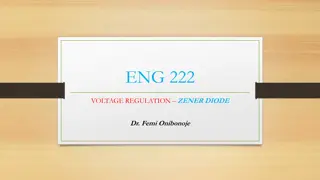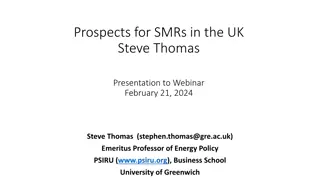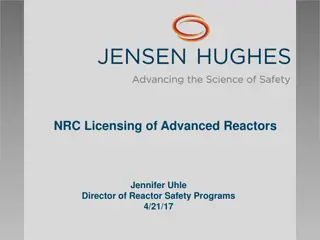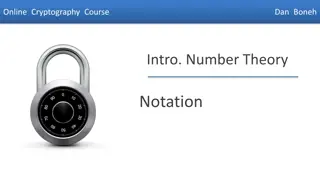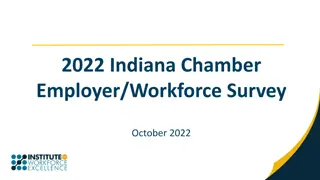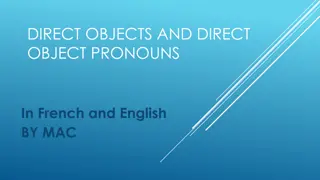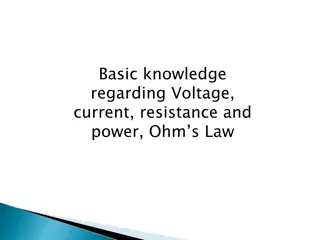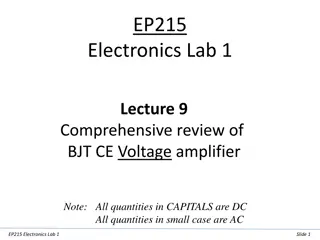Modular Education & Workforce Training in High Voltage Direct Current
Combine multi-educator, multi-industry collaborative development with delivery methods targeting multiple technician/engineering sectors. Build strong connections between certificate and degree programs and industry applied work. Strengthen necessary skills to design/deploy HVDC. Modules address onshore and offshore applications using interactive, textbook-quality methods. Engage with disadvantaged communities to decrease energy costs and environmental impact.
Download Presentation

Please find below an Image/Link to download the presentation.
The content on the website is provided AS IS for your information and personal use only. It may not be sold, licensed, or shared on other websites without obtaining consent from the author.If you encounter any issues during the download, it is possible that the publisher has removed the file from their server.
You are allowed to download the files provided on this website for personal or commercial use, subject to the condition that they are used lawfully. All files are the property of their respective owners.
The content on the website is provided AS IS for your information and personal use only. It may not be sold, licensed, or shared on other websites without obtaining consent from the author.
E N D
Presentation Transcript
SUMMARY: Combine multi-educator/ multi-industry collaborative development w/ delivery methods targeting multiple technician/engineering sectors; build strong connections between certificate & degree programs & industry applied work. Strengthen necessary to design/deploy HVDC. Each module addresses onshore & offshore applications; Uses Jupyter for interactive, text-book- quality modules: animations, & learning assessments; 33 organizations on project board serve as reviewers and co-authors; Deployed via colleges, voc. schools, certif. progs., short-courses, public internet website. COMMUNITY BENEFITS: Engage w/ disadvantaged comm. Bridgeport, CT on energy equity, to decrease energy cost and environmental impact; Address workforce & DEIA via multi-school design development; Others: see comm. benefit plan. PROJECT TITLE: HVDC-Learn: Modular Education & Workforce Training in High Voltage Direct Current Electric Transmission PRIME RECIPIENT: Iowa State University PRINCIPAL INVESTIGATOR: James McCalley, Distinguished & Chaired Professor REQUESTED DOE FUNDS: $700,000 SENIOR/KEY PERSONNEL: KEY IDEA: Develop & use educational modules to elevate the electric power community s awareness/understanding of the HVDC domain to increase HVDC deployment as an offshore & onshore transmission solution. 36 modules spanning the following 12 areas: (1) Introductory/Overview Coverage; (2) Station components; (3) Converters; (4)Control; (5) HVDC Protection; (6) HVDC Line and Cable Technologies; (7) Point-to-Point HVDC Configurations; (8) Multi- Terminal HVDC Networks; (9) Planning and Design; (10) HVDC System Simulation and Analysis; (11) Regulatory Permitting Processes/Procedures; (12_ Energy Equity and Environmental Justice module foundational skills Power Systems Hantao Cui, Assist. Prof., Oklahoma State Xin Fang, Asst. Prof., Mississippi State Eric Hines, Prof. of Practice, Tufts Fran Li, Chaired Prof., U. Tenn.-Knox. Per-Anders Lof, Lecturer, Tufts; Principal Engr, National Grid James McCalley, Chaired Prof., Iowa State Power Electronics Leon Tolbert, Chaired Prof., U. Tenn-Knox. Alex Stankovic, Chaired Prof., Tufts Ali Mehrizi-Sani, Assoc. Prof., Virginia Tech Johan Enslin, Chaired Prof., Clemson Moazzam Nazir, Rsrch Scientist, Clemson High Voltage Engineering David Wallace, Asst. Clin. Prof. Miss. State photos, videos, D D university, comm. Locations of 7 Project Locations Locations of 7 Project Locations GOALS: (1) Rigorous review; each module meets module performance target of 90%. (2) 50% of those in HVDC workforce indicate job impact by one or more modules IMPACT: At least 25% of nascent, ongoing, & mature HVDC projects influenced by modules.
SOME LOGISTICS SOME LOGISTICS A. MEETING TIMES: We wrote, The full project faculty team meets quarterly throughout the 3-year project duration. During the first two quarters, the PMT meets biweekly; this frequency reduces to monthly as the project matures. So can we meet in two weeks? Is Friday afternoon June 14 3-4pmCT possible for you? If not, I will send a poll to find a meeting time. B. CURRENT & PENDING SUPPORT: From Special Terms and Conditions, Term 45 Current and Pending Support: ISU must ensure all PIs and senior/key personnel at the recipient and subrecipient level, are aware of the requirement to submit updated current and pending support disclosure statements to DOE, within 30 calendar days of change in current and pending support. My plan: Limit subrecipient updates so that they are required only if a subrecipient is awarded a new project that will result in one month per year, or more, of their time during the duration of this project. If this sounds reasonable to the team, I will communicate it to DOE.
PROJECT OBJECTIVE PROJECT OBJECTIVE The objective of HVDC-Learn is to develop and use educational modules to elevate the electric power community s awareness and understanding of the HVDC domain to increase HVDC deployment as a transmission solution. electric power community - practicing engineers and technicians, corporate managers and executives, regulators, and community college and university educators and students; HVDC domain - HVDC technologies, design and planning methods, implementation procedures, operating approaches, and technical, economic, regulatory, social, and political impacts of deploying HVDC. Year 1: Complete 10 new modules Year 2: Complete 12 new modules Year 3: Complete 13 new modules 1. The completion of 35 modules with each module reviewed and course-tested: We have established criteria for board member reviews and course-related (community college, university, and short-courses) student feedback, on scale of 0-100, and we require each module to meet a module performance target of 90%. The impact modules and associated instruction have on people. To assess this, we will obtain permanent contact information from all persons receiving module-based instruction (including those downloading modules from our internet site) and survey them a year later. This will require a human impact performance target of at least 50% among respondents to indicate job impact by one or more modules. Review process: Each module is reviewed by 4 individuals, including a faculty team member and a project board member who are not co-authors. The other 2 reviewers may be within or outside the faculty team/project board. Review criteria is (i) relevance/significance; (ii) correctness/accuracy; (iii) readability/visual aesthetics; (iv) effectiveness; each scored 1-25, for max score 100. Following review, each module is delivered in an instructional environment, e.g., a university/college course, workshop, or short course, after which feedback is obtained from students/participants, and the module is updated. Modules must receiving an average reviewer score less than 90% must be revised and re- reviewed. 2.
PROJECT MANAGEMENT STRUCTURE PROJECT MANAGEMENT STRUCTURE REQUEST REQUEST: Each person below come to next meeting with one slide of how to address these responsibilities. Review project docs (technical vol, CBP, SOPO). Feel free to email/speak with me if that will help. Emphasize yr 1 goals & milestones (next 2 slides). Project manager McCalley has 4 responsibilities: (i) ensure project team members contribute as described here; (ii) ensure all tasks are completed on time and milestones are achieved; (iii) liaison with the project board; (iv) develop project infrastructure (module repositories and with H. Cui the searchable internet site and module material repositories. Module format coordinator, Cui, reviews all modules to ensure they satisfy basic requirements including logo, use of Jupyter, identification of learning objectives, and use of learning assessment via interactive questions. Work with McCalley to develop searchable internet site and module material repositories. Certificate manager, Mehrizi-Sani, works with schools where power-related certificates currently exist (ISU, UTK, MSU) to deploy modules within the certificate programs of those schools and leads efforts to initiate new certificate programs at the project team s schools. Short course developer, Fang, organizes our 3 planned short courses, making them available in both face-to-face & virtual formats. Advertising/outreach coordinator, Li, develops email list, ensures timely dissemination of work, coordinate 2 public seminars per year. The academic institution liaison, Nazir, engages other US colleges represented on our project board to facilitate module deployment and the multi-school design project. Community benefits coordinator, Hines, manages our community benefits plan to ensure this project benefits disadvantaged communities.
PROJECT ORGANIZATION & YEAR 1 GOALS PROJECT ORGANIZATION & YEAR 1 GOALS Year 1 budget period work-scope summary: Cui/McCalley: Develop project IT-related infrastructure (module repositories and searchable website). McCalley: Develop module summary table. McCalley: Use faculty team kickoff meeting and project board meeting (date?) to define processes & management procedures; Fang: Develop and offer year 1 short course; Li: Implement communication (advertising) and outreach program. McCalley/Hines: Meet twice with Bridgeport, CT., to assist in impacting energy costs and equity. Only McCalley will travel to Bridgeport for the two meetings in year one, with other faculty (at least 75%) participating virtually; years two and three meetings will be held entirely virtual. Nazir: Initiate multischool HVDC offshore design projects in universities/community colleges; Cui, Fang, Li, Lof, McCalley, Mehrizi-Sani, Nazir, Tolbert, Wallace: Complete 10 modules and course testing of 6 modules.
Milestone Table Milestone Table Quarter Quarter Milestone Milestone Description Description Evaluation/assessment method Evaluation/assessment method MCCALLEY MCCALLEY MCCALLEY MCCALLEY FANG FANG 1 1 1.1 Complete one module all but course testing and review. Module will be under review 2 2 3 3 1.2 1.3 Yr 1 project board meeting. Complete planning for yr 1 short course. Have 90% participation. Scheduled to occur before end of yr 1. 10 modules completed; 6 modules tested; 2 Bridgeport meetings. All tested modules have review scores 90%. 75% project team participation in Bridgeport meetings. Cui, Fang, Li, Lof, McCalley, Mehrizi-Sani, Nazir, Tolbert, Wallace 4 4 Go/NG 1 5 5 6 6 7 7 2.1 2.2 2.3 Yr 2 project board meeting. Implement communication outreach. Complete planning for yr 2 short course. Have 90% participation. Sent 3 times since project initiation. Scheduled to occur before end of yr 2. All tested modules have review scores 90%. 50% of people in workforce exposed to modules have used one or more of them. 75% project team participation in Bridgeport meetings. 12 new modules completed (total of 22) each with applications to energy equity. 11 modules tested (total of 18). Workforce using modules. 2 Bridgeport meetings. 8 8 Go/NG 2 9 9 3.1 Implement communication outreach. Sent 6 times since project initiation. 10 10 3.2 Use modules in 4 certificate program courses. Two programs are existing; two are new. 11 11 3.3 Complete course testing. All 35 modules used in instruction. All modules have review scores 90%. 50% of people in workforce exposed to modules use 1 or more. 75% project team participation in Bridgeport meetings. 13 new modules completed (total of 35). Workforce using modules. 2 Bridgeport meetings. 12 12 Final
MODULE COMPLETION SCHEDULE MODULE DESCRIPTIONS (yellow to be completed year 1; blue in year 2; white in year 3) LOADING BY PERSON AND YEAR
A Module A Module A mini-textbook Lead author, lead reviewer, possible co-authors, team, multi-stage review. Self-contained 5-30 pages Address an HVDC feature/issue Clear learning objectives Both on/offshore applications Targets university engineering courses industry-focused short courses community colleges Regulatory & policy groups individual learning. Any suggestions to Logo or to this format, please send by June 7 !!! Any suggestions to Logo or to this format, please send by June 7 !!!
Module development and review process Module development and review process Underlying philosophy: The design/content of a module, though led by one of us, is influenced by all of us. We all see what is in every module. The review process is multi-stage: (i) lead-reviewer, (ii) team, (iii) formal review, (iv) course testing. 1. Project advisory board (PAB) considers table of modules. Some PAB members may volunteer to serve as co-authors of certain modules. 2. Development process: a. Lead author develops V1a (competencies & objectives identified; fairly well-developed intro, section headers, some writing in sections, some figures/tables). b. Share w/ lead reviewer (& any co-author); develop V1b (fairly mature) based on comments. c. Share w/ team, address comments from team. d. Authors complete module; this is V2. 3. Review & testing process: a. Submit V2 for review; 4 required: lead reviewer (coordinates), at least 1 PAB member, 2 more. b. Develop V3 based on reviewer comments. c. Course-test (in short course and/or other course). d. Develop V4. 4. Post to publicly available website (with periodic revision). 2 weeks 3 months 1 month 2 months
What are our current priorities? What are our current priorities? Start on year 1 modules: McCalley, 7a Pt 2 pt onshore & offshore apps, Q1 EARLY COMPLETION OF THIS (AND DISTRIBUTE!!!) Fang, 1c - Intro to HVDC for offshore wind, Q2 Li, 1b - Application Guide for HVDC Transmission, Q2 Lof, 1a - Intro to HVDC technology, Q2. Mehrizi-Sani, 2a - HVDC reactive power, EMI, and filter design, Q3 Tolbert, 3d - Modular multilevel converter as HVDC cnvrtr interface and its control, Q3. Wallace, 5a - HVDC fault management & protection systems, Q4. Cui, 2b - VSC-HVDC converter station technologies, Q4 Nazir, 4d - Offshore HVDC cnvrtr grid forming controller design for black start capability, Q4. Comment on project logo and module summary table per slide 7 by June 7 (all). Submit project logo and module summary table to DOE (McCalley). Develop website (Cui/McCalley). Begin developing short course (Fang). Organize first PAB meeting by end of Q1 (McCalley). Organize visit to/meeting with Bridgeport (McCalley/Hines). Initiate multischool HVDC offshore design projects (Nazir). McCalley, Cui, Fang, Nazir, develop 1 slide (per slides 4-5) for next meeting. 10. Next meeting on June 14 Project Kickoff and will invite DOE. 11. Tell me if you are hiring student 3 need to be hired by end of Q2, 1 of them female, w/div-search. 1. 2. 3. 4. 5. 6. 7. 8. 9.
Inclusion & accessibility Inclusion & accessibility FROM OUR COMMUNITY BENEFITS PLAN: In this project, we will supplement our institutions efforts and raise our awareness by purchasing two inexpensive but high-quality and highly recommended recent books on these subjects [inclusion & accessibility] for each member of our project faculty team. All faculty team members are interested in these books, but to encourage that interest, Dr. McCalley will make it a habit at each project management team meeting to refer to one or more parts of these books. In this way, we intend this project to influence perspective on inclusion and accessibility for the remainder of these 12 faculty members careers. PLEASE SEND ME YOUR MAILING ADDRESS PLEASE SEND ME YOUR MAILING ADDRESS SO I CAN SEND YOU THESE BOOKS. SO I CAN SEND YOU THESE BOOKS. D. Singh, Actions speak louder than words: a step-by-step guide to becoming an inclusive workplace, Penguin Random House LLC, 2022, www.google.com/books/edition/Actions_Speak_Louder/8KZPEAA AQBAJ?hl=en&gbpv=1&printsec=frontcover. A. Wong, editor, Disability visibility: first person stories from the twenty-first century, 2020, www.google.com/books/edition/Disability_Visibili ty/0jbGDwAAQBAJ?hl=en&gbpv=1&printsec=fr ontcover.
